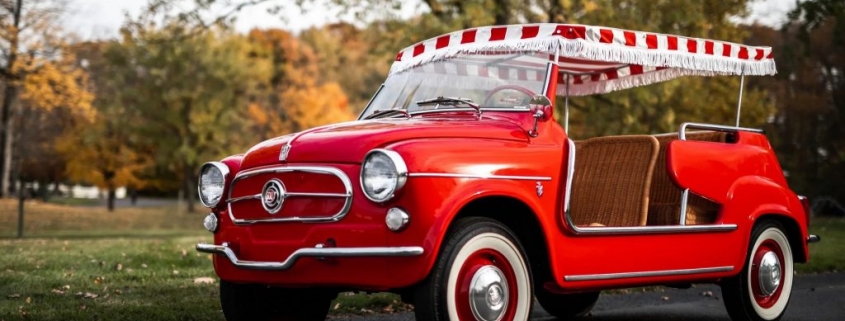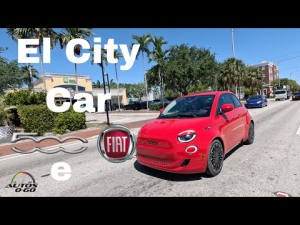Why Are People Paying 6 Figures for the Fiat Jolly?
Roofless supercars like the Aston Martin V12 Speedster might be hot items now, but the roadster formula is a classic one. And it’s one that, historically, wasn’t limited just to limited-edition, high-dollar vehicles. However, over the years some of these classic roadsters have become valuable in their own right. And when it comes to the Fiat Jolly, that value can be surprisingly high.
The Fiat Jolly turned the 500 and 600 into classic roadsters, complete with wicker seats
At first, the Fiat 500 and 600 were designed as affordable people-movers to get Italy mobile after WWII. The base 500 even had a fabric roof to save on then-pricey steel. But as the ‘50s and ‘60s rolled on, both cars started evolving beyond their initial intentions. Abarth made them into race cars, for example. The Fiat Jolly roadster, though, arguably took the 500 and 600 the farthest from their utilitarian roots.
Reports and histories conflict regarding the origins of the Fiat Jolly, Classic & Sports Car explains. But the legend goes that Gianni Agnelli, then head of Fiat, wanted a car that could drive to and onto his luxury yacht. Sort of like a beach buggy, but less about off-roading and more about style. And Agnelli supposedly commissioned Italian coachbuilder Carrozzeria Ghia to design and build his dream beach car.

Whether or not Agnelli himself inspired the Fiat Jolly, Ghia designed the little roadster with “wealthy seaside dwellers” in mind, Hagerty says. Or rather, Ghia designed the little roadsters. There are two versions of the Fiat Jolly: one based on the 500 and one based on the 600. But while the Jolly models have different engines, their overall designs are virtually identical.
To turn a 600 or a solid-roofed 500 into a Fiat Jolly, Ghia replaced the car’s metal roof with a removable fabric one. The coachbuilder also removed the doors as well as the side and rear windows, and modified the side panels, Hemmings explains. And all Jollies have wicker seats because they hold up better when exposed to water, sand, and sunshine.
A well-maintained Fiat Jolly can cost $100,000 or more at auction

Classic Fiat 500s tend to sell at higher prices than used versions of their US-market successors. But neither holds a candle to the auction price of a pristine Fiat Jolly.
In good condition, a Fiat Jolly can easily sell for $45K-$50K, Hagerty reports. And because of their bigger, stronger engines, the 600 models command a slight premium. However, pristine Jollies often cross the auction block for $100,000 or more. And this trend doesn’t appear to be over yet.
At the beginning of June 2021, a 1958 Jolly 600 sold on Bring a Trailer for $130,000. A month earlier, RM Sotheby’s sold a 1959 Jolly 500 for $106,400. And in March 2020, RM Sotheby’s sold a 1959 Jolly 600 for $151,200.
Why are these vintage beach buggies so expensive?
To be sure, expensive classic roadsters are nothing new. Paying $2 million for a BMW 507, for example, isn’t out of the ordinary. But why pay so much for something like a Fiat Jolly?
Firstly, these are rare roadsters. When it was new, a Jolly 600 was roughly three times as expensive as the standard car, The Drive notes. Sources differ on exact production figures, but Hagerty estimates Ghia built 650 examples. And because these were intended as beach vehicles, more than a few rusted away in the salty air.
Secondly, the Fiat Jolly is a quirky machine with a significant charm factor. With no doors, roof, or seatbelts, it’s not practical. And with a realistic top speed of 60 mph, it’s not necessarily fast. But driving one encourages you to take in life and your environment without hurry and not too seriously. It’s a “whimsical” car that’s easy to run and perfectly captures the romance of the ‘50s and ‘60s, Hemmings says.
Emotional attachment is a big reason why people covet classic cars and shell out large sums for them. Why do people pay six figures for a Fiat Jolly? Because it makes them smile.
Follow more updates from MotorBiscuit on our Facebook page.
RELATED: The Autobianchi A112 Is the Forgotten Classic Fiat Abarth
The post Why Are People Paying 6 Figures for the Fiat Jolly? appeared first on MotorBiscuit.







